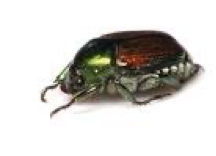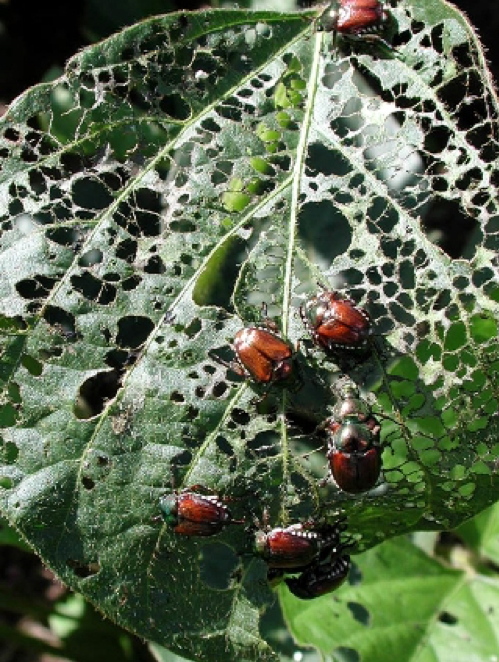
Japanese beetles have a unique array of colors with a shiny exterior. They’re around ½ inch long with copper and green hues as well as white fuzzy spots. You’ll probably find them gathered in your pool filter or perched on plants in your garden. Japanese beetle season in California is short, as they emerge in May or June, only lasting through the end of the summer. They originated in Japan, but quickly became a nuisance for homeowners across America in the early 1900s. The problem with Japanese beetles is that they are highly destructive to vegetation around your property. They flock in the hundreds, even thousands at a time, consuming leaves. All that is left behind is what looks as if the leaves have been torched and skeletal. Japanese beetles reproduce quickly and are clumsy flyers. Although they’re not diving in for an attack, they have no problem bumping into you multiple times as they fly around.
Are Japanese beetles dangerous?
Japanese beetles are not known to bite or attack humans. Although they might be clumsy flyers and bump into you, they aren’t a health risk. Japanese beetles feed on plants, so they don’t infest homes like other common pests in our area. Their true danger lies in their ability to quickly decimate vegetation as they eat in large quantities.
What attracts Japanese beetles to my property?
Japanese beetles begin as grubs in the ground and emerge in the thousands between May and June. Individual adult Japanese beetles live only 30-45 days on average, but their young, referred to as “grubs,” will live in the soil for several months before hatching. Their primary food source consists of leaves, particularly on dry or older plants. There is little you can do to prevent Japanese beetle activity on your property due to their ability to hide underground and emerge quickly in large communal groups.
Will Japanese beetles destroy my garden?

Japanese beetle eggs hatch into grubs, which feed on plant roots while developing within the ground for several months before emerging as full size Japanese beetles. The adults feed on leaves, flowers, and decaying fruit, all of which are commonly planted in gardens on residential properties. Once Japanese beetles find an ideal plant, they chew through leaves and flowers leaving the veins exposed. The tell-tale signs of Japanese beetle activity is the damage they cause to leaves. The leaves look almost skeletal, as if they were completely scorched in a fire. Japanese beetles come out in large groups and feed together and are not picky when it comes to the type of plant they attack.
In addition to gardens, Japanese beetles also go after grass, eating the roots and causing large brown patches across your yard. If it escalates, this will become more than just a cosmetic problem. Exposed, dry soil and dead plants can attract other pests.
Why are Japanese beetles in my pool?
Many people open up their pool filter in the summer, only to find large groups of dead Japanese beetles which won’t stop, no matter how many times it’s clean it out. The reasoning is simple. Beetles accidentally fall into the pool and can’t fly back out. The phenomenon plagues pool owners every year with seemingly no way to get rid of them. Like other beetles and flying insects that end up in your pool, the only way you can prevent Japanese beetles from dying in your pool is to prevent them from feeding on the foliage on your property.
How can I get rid Japanese beetles?
Keeping your plants well-watered and healthy may deter Japanese beetle activity because they prefer dry vegetation to feed on. A tedious, but effective way to get rid of Japanese beetles is to physically pick them off of plants and dropping them into a solution to drown them. There are several products that you can buy at big box retailers for the control of Japanese beetles. Tools like Bag A Bug can be very useful for DIY solutions at your home. Speak to your landscaper before engaging in any Japanese beetle pest control on your own.
What Are Japanese Beetles? Professional Pest Control Services in Tracy CA
Serving



